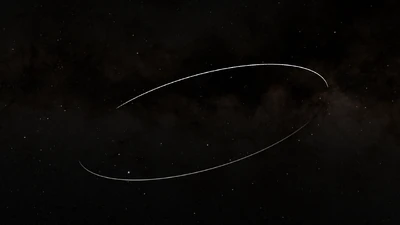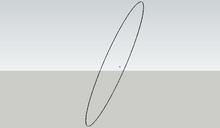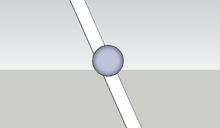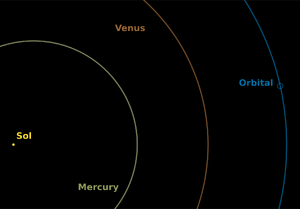
An Orbital is a large ring-shaped space habitat.
Description[]
Structure[]
An Orbital is constructed from segments called Plates.[1][2] The Plates are constructed of ultradense[3], or exotic,[2] materials. The inner surface of Plates are flanked by retaining walls[4] called Edgewalls;[3][5] the Edgewalls prevent the spinning Orbital's atmosphere from escaping.[2]

An Orbital with a 10 million kilometre circumference, 3 million kilometre diameter and 6 thousand kilometre breadth, with an Earth-sized sphere for comparison (the sphere is placed next to the near side of the Orbital).
A small space station called a Hub may be placed at the centre of the Orbital. The Hub typically contains the Orbital's governing authority.[1][2]

Close up of an Earth-sized sphere resting on the inner surface of a typically-sized Orbital (dimensions as above).
Orbitals may be constructed with as few as two Plates. In these cases, the Plates are placed opposite one another and tethered to each other only by force fields;[2] the combined structure is spun. The ring is completed by the incremental addition of Plate-pairs.[6]

A to-scale diagram of Earth's solar system, if Earth were replaced by a typical Culture orbital.
Orbitals come in varying sizes. Orbitals with diameters ranging from approximately one,[5] to ten million kilometres existed.[7][8] Plates may be thousands,[2][7] even tens of thousands, of kilometres wide.[3] Edgewalls may be thousands of kilometres tall.[3][2] For instance, Vavatch orbital[9] was said to be 14 million km long, and 35 thousand km wide, which would give it a diameter of about 4.46 million km and a usable surface area of about 490 billion km2 - over 960 times the surface area of the earth.
Surface environment[]
Conditions on the inner surface are widely customizable.
Orbitals spin to create artificial gravity through centrifugal force,[3][2] and to create a day-night cycle.[1][2] Local day and night are produced whenever a given part the Orbital's interior is facing toward and away from the local star, respectively.[2]
Additional mass is lowered onto Plates, altered, and shaped to create a variety of terrain;[10][11] the volume between the Plate's inner surface and the surface of the terrain need not be solid, and may contain additional facilities.[12] An Orbital may house multiple biospheres[7] and biomes.[10][11]
The weather may be manipulated using energy injection and fields.[13]
A 3 million kilometre diameter Orbital may be populated by tens of billions of pan-humans[10] with multiple Plates uninhabited.[3]
Facilities[]
The volume of the Plate below the inner surface is called the sub-Plate; access points between the surface and the sub-Plate are spread throughout an Orbital.[14][12]
The outer surface of Orbitals and Plates is the underside.[3][2] Spaceports are located along the underside.[14][12] Long-distance transportation links may also run along the underside, using the vacuum to achieve high speeds.[2]
By polity[]
The Culture[]
The Culture built Orbitals as mass-efficient ways of creating abundant living space.[15][6] The Culture had been building Orbitals for millennia before the 22nd century CE.[16]
The Culture constructed Orbitals from asteroids, comets, and other miscellaneous debris; a typical star system had enough of this material for at least one Orbital, and using them reduced collision threats to Orbitals. Material could be imported over interstellar distances as necessary. The Culture did not mine planets for building materials.[6]
Space debris was also used to create the terrain on new Plates. Asteroids were lowered toward the surface and rendered molten by energy projectors - equivalent to planetary crust-busting weapons. The molten slag was shaped and distributed onto the Plate using other matter- and energy-manipulating processes.[17][16]
The Culture considered 4 sextillion kilograms sufficient to construct an Orbital with a surface area of 10 billion square kilometres; the Orbital would have a maximum population of 50 billion.[6]
Most Culture Orbitals in the 22nd century were 3 million kilometres in diameter.[2]
The Culture's definition of an Orbital had a minimum size, and was for an unenclosed structure.[18]
The typical ratio of land to water is 1:3.[6] Wastelands and badlands were considered part of a balanced environment.[11] Orbitals were spun to produce 1 standard gravity.[2]
Most Culture citizens lived on Orbitals;[6] this amounted to more than 95% of the population in the 29th century CE.[19]
A Mind served as administrator for each Orbital. The Mind was housed in the Hub, and was typically addressed as same.[20][2]
High-speed transportation across the Orbital was provided by the underside and sub-Plate network. Settlements were liberally provided with network access point; even isolated houses in rural areas could be provided with an access point.[6] The underground cars used by the networks also served as lifeboats.[12]
Complete Orbitals could be moved at superluminal speeds over interstellar distances; they had slow acceleration.[12]
Affronter polity[]
The Affront received Orbital technology from the Culture within 500 years of the end of the Idiran-Culture War.[21] The Culture hoped to reduce the Affront's reliance on planetary habitats and the Affront did not trust the Orbitals built for them by the Culture.[22]
References[]
- ↑ 1.0 1.1 1.2 Consider Phlebas, chapter 8
- ↑ 2.00 2.01 2.02 2.03 2.04 2.05 2.06 2.07 2.08 2.09 2.10 2.11 2.12 2.13 2.14 Look to Windward, chapter 12
- ↑ 3.0 3.1 3.2 3.3 3.4 3.5 3.6 Consider Phlebas, chapter 5
- ↑ Look to Windward, chapter 3
- ↑ 5.0 5.1 Surface Detail, chapter 3
- ↑ 6.0 6.1 6.2 6.3 6.4 6.5 6.6 "A Few Notes on the Culture"
- ↑ 7.0 7.1 7.2 Excession, chapter 7.2
- ↑ Hydrogen Sonata, chapter 14
- ↑ Consider Phlebas, chapter 3
- ↑ 10.0 10.1 10.2 Look to Windward, chapter 7
- ↑ 11.0 11.1 11.2 Look to Windward, chapter 9
- ↑ 12.0 12.1 12.2 12.3 12.4 Look to Windward, chapter 13
- ↑ Look to Windward, chapter 15
- ↑ 14.0 14.1 Consider Phlebas, chapter 7
- ↑ Consider Phlebas, Reasons: the Culture
- ↑ 16.0 16.1 Look to Windward, chapter 5
- ↑ Player of Games, chapter 4
- ↑ Excession, chapter 2.3
- ↑ Hydrogen Sonata, chapter 20
- ↑ Player of Games, chapter 1
- ↑ Excession, chapter 2.2
- ↑ Excession, chapter 3.3
External links[]
- Banks' Orbital - in the fictional Orion's Arm universe
